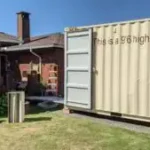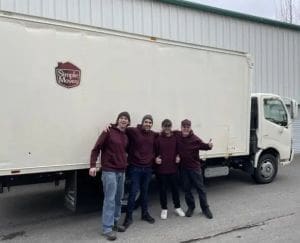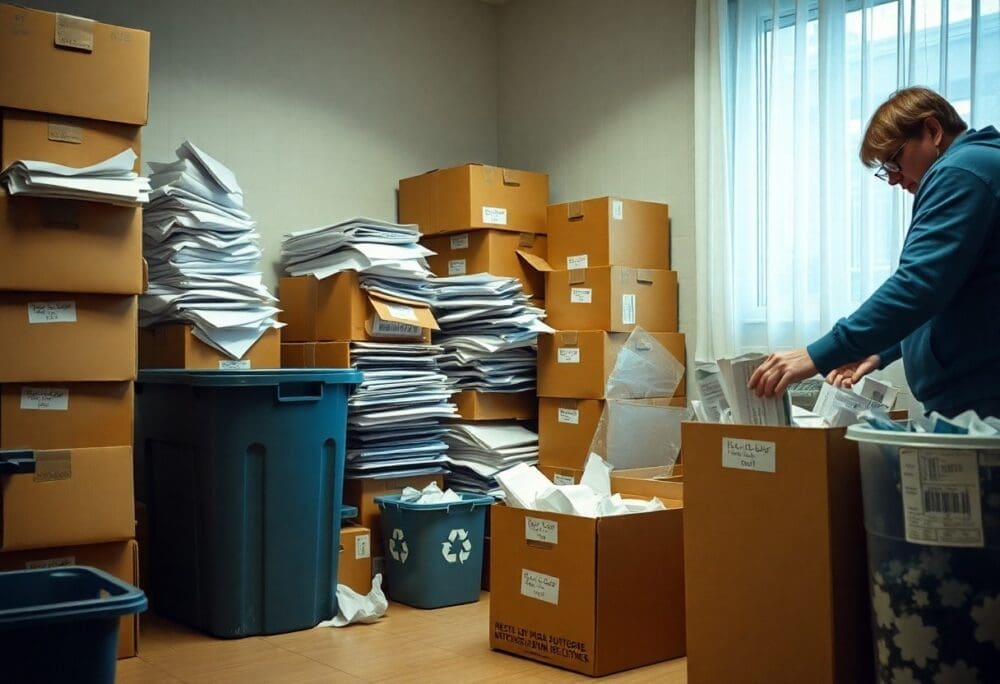Just like any other clutter, boxes and papers can accumulate quickly, making your space feel chaotic. You may find it challenging to determine the best ways to dispose of these items responsibly and efficiently. This guide will provide you with practical tips and best practices for sorting, recycling, and removing unwanted boxes and papers from your home or office, helping you create a cleaner, more organized environment. By following these methods, you’ll not only declutter your space but also contribute to environmentally friendly waste management.
Key Takeaways:
- Sort and categorize: Begin by sorting boxes and papers into keep, recycle, and discard categories to streamline the junk removal process.
- Shred sensitive documents: For papers containing personal information, ensure they are shredded to protect your privacy before disposal.
- Utilize recycling and donation options: Take advantage of local recycling programs and donation centers for boxes and papers in good condition to minimize waste.
Understanding Junk Removal
Additionally, understanding junk removal is necessary for maintaining a clutter-free space. This involves knowing the types of junk you have and the best methods for disposing of it responsibly. Effective junk removal not only enhances the organization of your home but also promotes a healthier living environment by minimizing allergens and pests attracted to clutter.
Importance of Proper Junk Removal
Removal of junk, especially boxes and papers, goes beyond aesthetics; it plays a significant role in ensuring your space feels open and inviting. Proper disposal methods also help protect your privacy and keep sensitive information out of the wrong hands, making it an necessary practice for every homeowner.
Environmental Impact of Discarded Materials
By neglecting proper junk removal, you can contribute to environmental degradation. Discarded materials often end up in landfills, where they can take years to decompose and leach harmful chemicals into the soil and water supplies. This not only affects the ecosystem but also poses risks to the health of you and your community.
Understanding the environmental impact of discarded materials requires awareness of the life cycle of the products you use. Every box and piece of paper you dispose of carries an ecological footprint. Recycling and disposing of these materials correctly can significantly reduce waste and conserve resources, allowing for a more sustainable future. By making conscious decisions about how you handle junk, you are contributing to a healthier planet for yourself and future generations.
Preparing for Junk Removal
The process of preparing for junk removal involves assessing your space and gathering crucial supplies to streamline the task. Start by designating a specific area for your junk and identifying the items that need to be removed. This will help create an organized approach, making the actual removal process easier and more efficient.
Sorting and Categorizing Items
By taking the time to sort and categorize items, you can ensure a more effective junk removal process. Group similar items together, such as keeping old boxes apart from paper documents. This allows you to determine what can be recycled, donated, or disposed of, simplifying the decision-making process during removal.
Essential Tools and Supplies
Essential tools and supplies can significantly enhance your junk removal experience. You’ll want to gather items such as boxes, tape, scissors, gloves, and markers for labeling. Having these tools at hand makes it easier to pack and transport your discarded items efficiently.
A few additional supplies can further improve your process. Consider using trash bags for smaller items, a dolly or cart for transporting heavier boxes, and a shredder for sensitive documents. These tools will help you maintain safety and organization while you work through your junk removal project.
Best Practices for Box Disposal
Many people overlook the best practices for disposing of boxes, but proper disposal can minimize waste and environmental impact. Start by flattening your boxes to save space and make recycling easier. Check with your local recycling guidelines for specifics and consider utilizing resources like the Ultimate Guide: How to Prepare for Junk Removal Services to ensure efficient disposal.
Recycling Cardboard Boxes
Below are some necessary tips for recycling cardboard boxes. Make sure to remove any non-recyclable items such as packing tape, labels, or plastic components. Flatten your boxes and place them in the recycling bin to help them get processed efficiently. Most communities have local drop-off points for recycling; check to see if your area offers curbside pickup as well.
Repurposing and Donation Options
Practices like repurposing and donating your boxes can be beneficial. Before recycling, consider whether your boxes can be reused for storage, shipping, or crafting projects. Local charities or shelters often appreciate donated boxes for transporting goods, making this a great way to give back to your community while reducing waste.
But taking things a step further, you can creatively repurpose your boxes into various DIY projects around your home. Whether it’s turning them into organizers, art supplies, or even furniture, your imagination can transform unwelcome clutter into functional items. By donating them, you not only help those in need but also contribute positively to the environment by minimizing landfill waste.
Best Practices for Paper Disposal
Now that you’ve sorted through your papers, it’s necessary to dispose of them responsibly. Start by categorizing your documents into sensitive items and those that can be recycled or thrown away. This method helps maintain your privacy and minimizes environmental impact. Make use of local recycling services to ensure that your old paper gets a second life, while also keeping your space clutter-free.
Shredding Sensitive Documents
To protect your personal information, always shred documents containing sensitive data, such as tax returns, bank statements, and any paperwork with personal identifiers. Utilizing a shredder not only prevents identity theft but also ensures that these documents are disposed of securely. Many local offices also offer shredding events, which may be an excellent option for bulk shredding.
Recycling vs. Trash
Trash may seem like an easy option for unwanted paper, but many types can be recycled. Before tossing any paper products into the bin, check with your local recycling guidelines. Items like printed paper, cardboard, and magazines can often be recycled, while certain types, such as those soiled or made from mixed materials, should be discarded as trash.
Also, recycling your paper helps reduce waste in landfills and conserves natural resources. By correctly separating recyclable papers from your trash, you contribute to a more sustainable environment. Many municipalities offer curbside pick-up for recyclable paper materials, making the recycling process more accessible for you. Emphasizing recycling can significantly impact our planet, so take the time to sort properly.
Hiring Professional Junk Removal Services
Once again, enlisting the help of professional junk removal services can simplify the process of decluttering your space. These experts are equipped to handle all types of waste, including boxes and papers, ensuring that your unwanted items are disposed of responsibly. By hiring a professional service, you save time and effort while ensuring that the removal is completed efficiently and safely.
When to Consider Professionals
Consider turning to professional help when the volume of junk becomes overwhelming or when you face time constraints. If sorting through your items feels daunting or if the logistics of transport pose a challenge for you, calling in a team of professionals can provide the assistance you need. This approach ensures a thorough and swift removal process, saving you hassle in the long run.
Choosing the Right Service Provider
Professionals in the junk removal industry come in all shapes and sizes, so choosing the right service provider is necessary. Look for a company with proven experience, positive customer reviews, and transparent pricing. It’s beneficial to check if they are licensed and insured, ensuring that your property is protected during the removal process while adhering to local regulations.
In addition, you should consider asking about their recycling and disposal practices, as some companies prioritize eco-friendly methods. A service that takes the extra step to donate or recycle items can be a significant advantage for environmentally-conscious consumers. Evaluate their customer service and responsiveness during your initial interactions, as this will reflect how they prioritize your needs throughout the entire process.
DIY Junk Removal Tips
Despite the overwhelming nature of junk removal, there are effective strategies you can employ to make the process smoother. Consider the following tips:
- Sort items by type
- Recycle or donate what you can
- Use sturdy boxes for packing
- Set a timer to stay focused
- Enlist help from friends or family
The organized approach will significantly ease your junk removal process.
Safe Lifting and Carrying Techniques
Any time you handle heavy boxes or papers, ensure you practice safe lifting techniques to avoid injury. Bend at your knees instead of your waist, and keep the load close to your body. Your core should engage to provide support while lifting, and always consider asking for assistance with particularly heavy items.
Efficient Transportation Methods
Against the odds of making multiple trips, plan your transportation effectively to save time and energy. Utilize larger vehicles when possible, or consider renting a truck if you have a substantial amount of junk to remove.
For instance, if you’re using your own car, layer boxes carefully to maximize space, while securing loose items to prevent damage during transit. You can also utilize storage bins and bags to consolidate materials, making it easier to load and unload at your disposal site. Proper planning will help you move your junk efficiently without unnecessary hassle.
To wrap up
Following this guide on best practices for junk removal of boxes and papers, you can streamline the decluttering process and make a positive impact on your space. Start by categorizing and sorting your items methodically, ensuring that you recycle, donate, or dispose of paper and boxes responsibly. Consider investing in storage solutions for items you wish to keep, and schedule regular clean-outs to maintain order. By implementing these strategies, you can create a more organized and efficient environment in your home or office.
Q: What materials can be recycled from cardboard boxes and paper?
A: Most cardboard boxes can be recycled as long as they are clean and dry. This includes shipping boxes, cereal boxes, and paper towel tubes. For paper, newsprint, office paper, and magazines can typically be recycled. Always check your local recycling guidelines, as they may have specific rules about certain types of materials, like heavily soiled pizza boxes or colored paper.
Q: What is the most efficient way to break down cardboard boxes for disposal?
A: To efficiently break down cardboard boxes, first remove any tape or packaging materials. Flatten each box by cutting along the seams with a utility knife or box cutter. This not only helps save space when storing for recycling but also makes the recycling pick-up easier for collection services. Ensure that the flattened boxes are stacked neatly to avoid them getting blown away by the wind.
Q: How can I securely dispose of sensitive documents without risking identity theft?
A: To securely dispose of sensitive documents, consider using a shredder that can handle paper, credit cards, and other documents. Shred the papers before disposal to protect your personal information. Alternatively, you can gather your sensitive documents and take them to a local shredding event or a professional shredding service that offers secure document destruction for an additional layer of safety.





